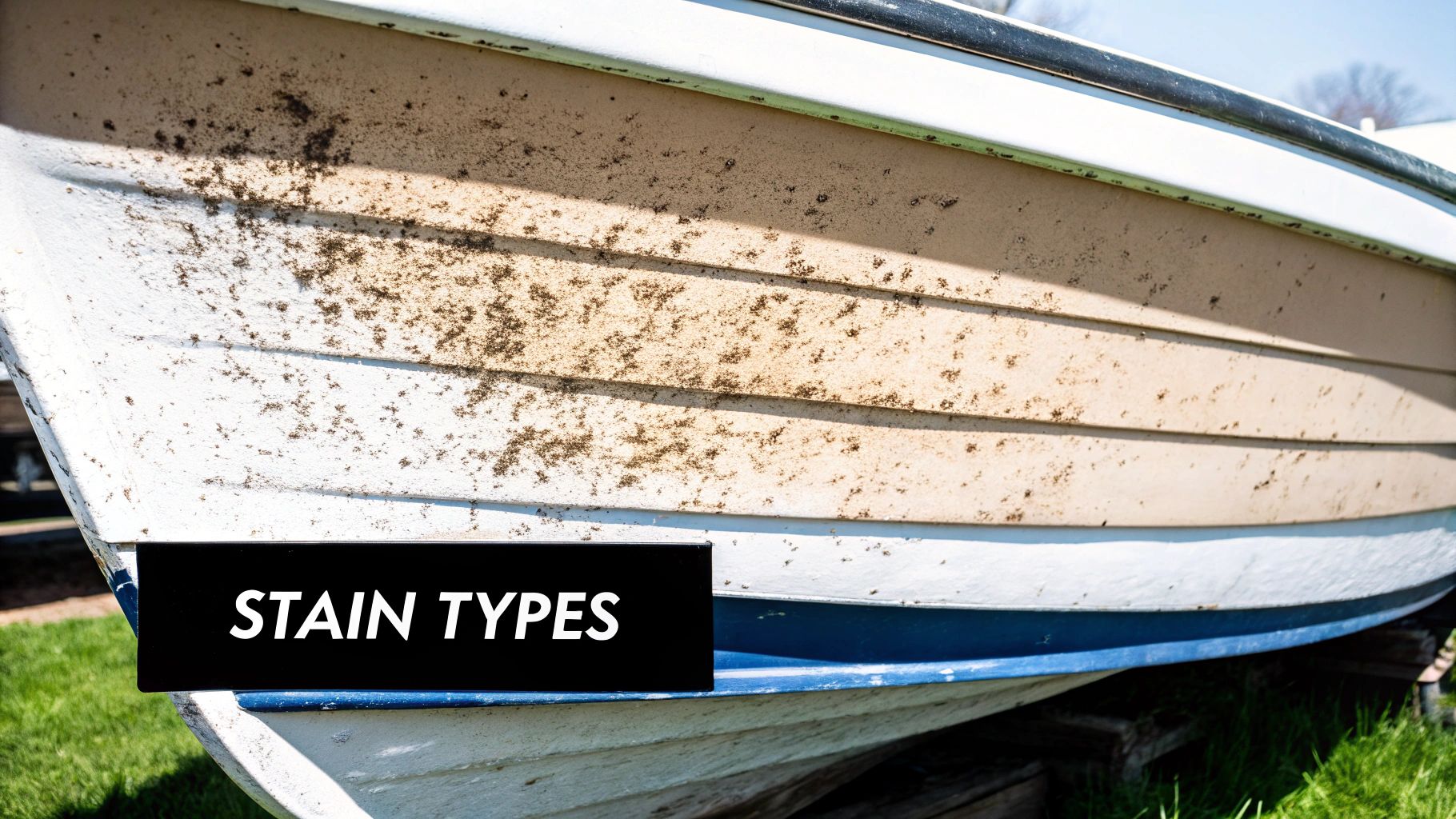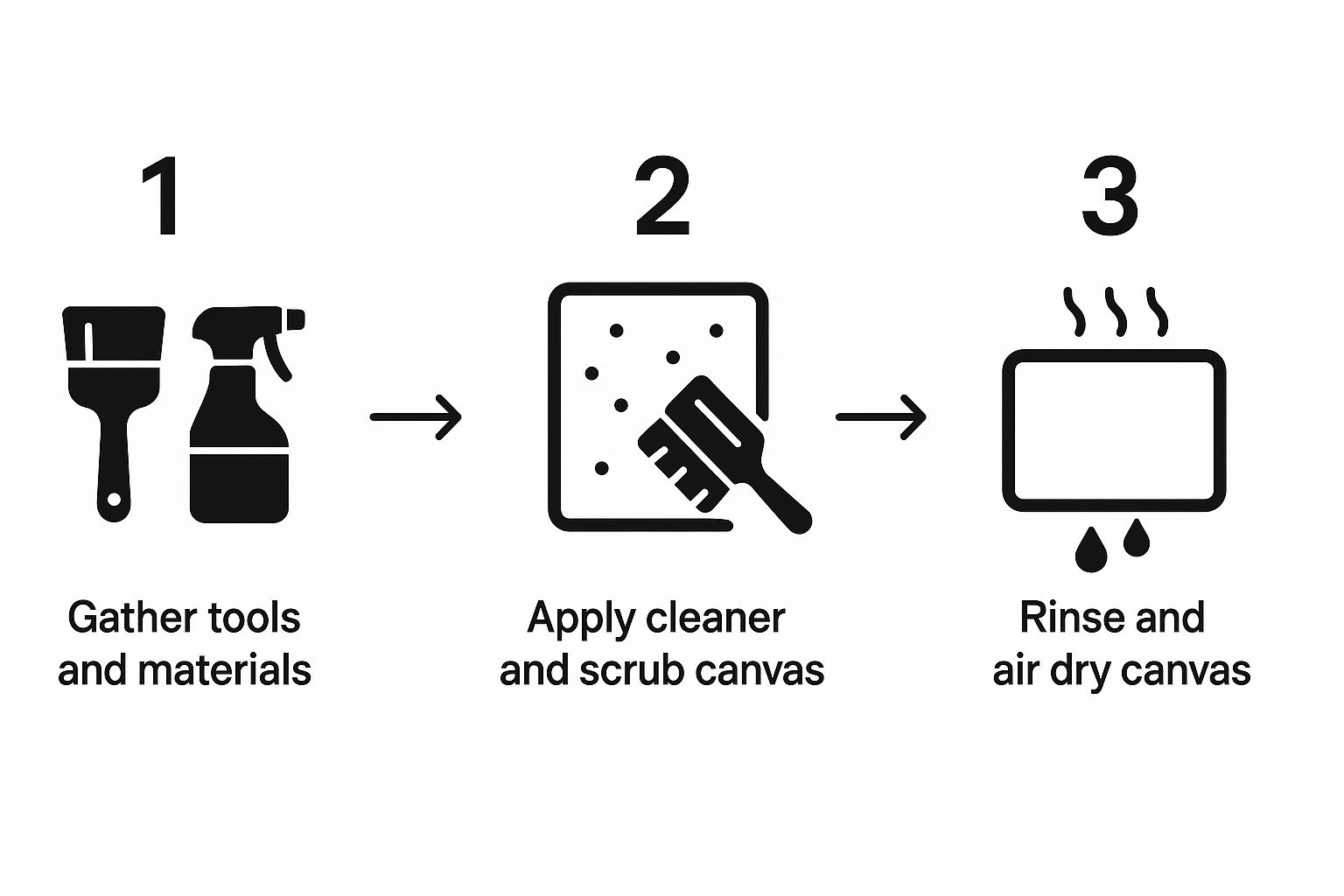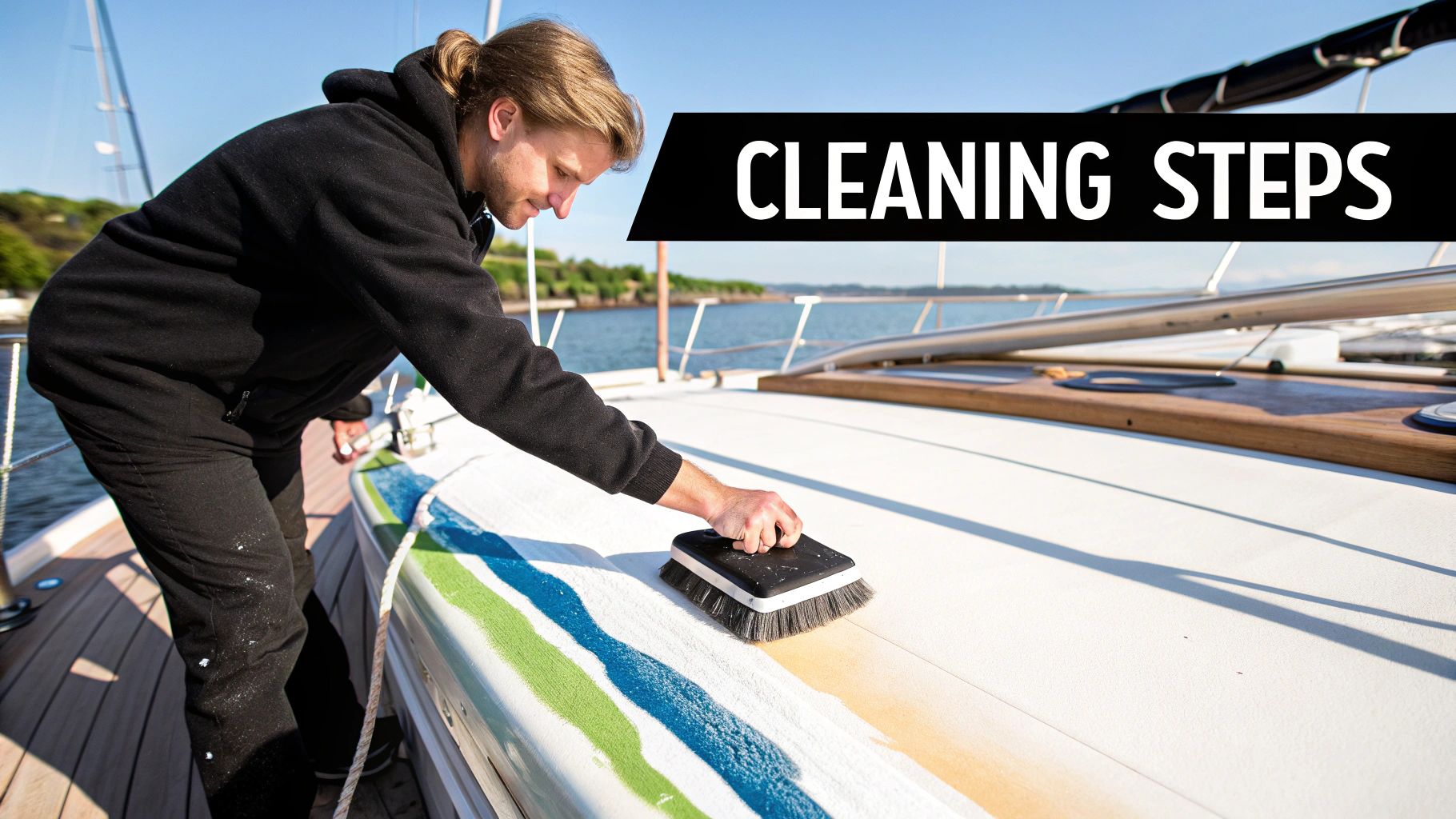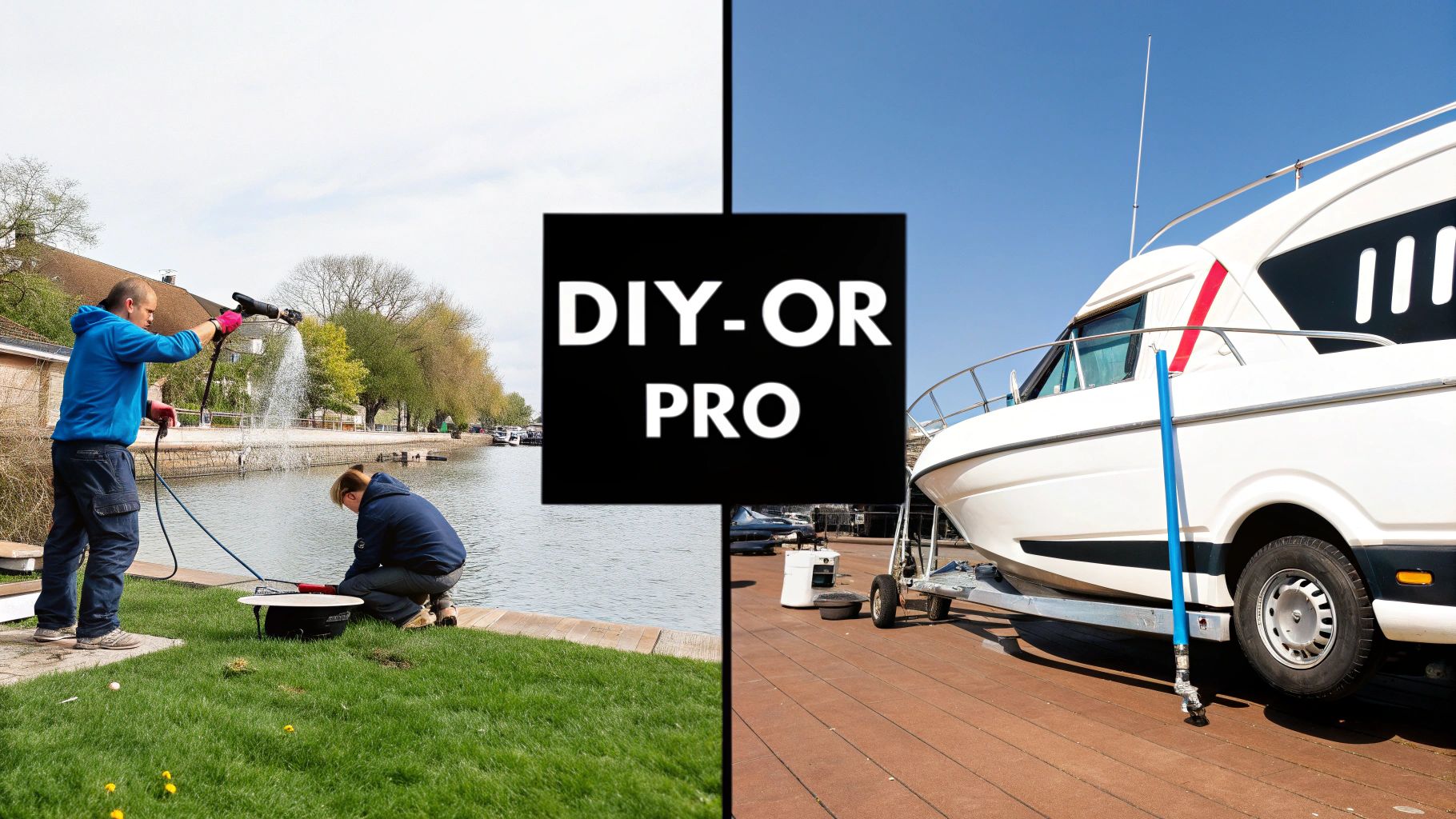A Guide to Boat Canvas Cleaning
Keeping your boat canvas clean is about so much more than just looking good at the dock. It’s a crucial piece of protecting your vessel's value. Think about it—consistent care is what stands between your boat and the damaging effects of saltwater, harsh UV rays, and everyday grime, preventing premature wear and tear that can lead to expensive replacements.
Why Regular Canvas Care Is Essential for Your Boat
Your boat’s canvas is its first and most important line of defense against the tough marine environment. It’s constantly shielding your cockpit, upholstery, and sensitive electronics from the relentless sun, corrosive salt spray, and those lovely surprises from passing birds.
Ignoring your canvas is a bit like spotting a small leak in your roof at home and deciding to deal with it later. We all know how that ends—the problem only gets bigger, and the repair bill gets much, much uglier.
Treating routine canvas cleaning as an investment, rather than a chore, is the key. A little bit of time spent now directly saves you from the major headache and cost of a full canvas replacement down the line. When you let stains like mildew or rust sit, they don't just look bad; they can permanently weaken the fabric's fibers and ruin its water resistance.
Protecting Your Investment and Pride
Beyond the practical, a pristine canvas just feels good. It’s the finishing touch that keeps your boat looking sharp and maintains that sense of pride every owner knows. This isn't just about looks; it's about responsible boat ownership. A clean, well-kept canvas is a tell-tale sign of a well-cared-for boat, which is a huge plus when it comes time to sell.
This focus on proactive maintenance is a big deal across the industry. The market for marine cleaning products, which includes everything for canvas care, was valued at a massive USD 100.1 billion in 2023 and is expected to nearly double by 2030. That kind of growth shows just how much boaters are focusing on proper upkeep.
Pro Tip: The easiest way to stay on top of canvas care is to roll it into your regular boat washing routine. When you're washing the hull or cleaning the decks, just take a few extra minutes to give the canvas a good rinse and a quick inspection.
This simple habit makes the whole process feel less like a project and helps you catch small problems before they become big ones. For more ideas on how to build a smart upkeep schedule, check out our guide on essential boat maintenance tips that every boat owner can use.
Ultimately, a little consistent care ensures your canvas—and by extension, your entire boat—stays in top-notch condition for many more seasons of enjoyment.
Gearing Up: Your Boat Canvas Cleaning Toolkit

Before you can even think about scrubbing away that layer of grime, you’ve got to gather the right gear. Trust me, effective boat canvas cleaning isn't about brute force; it’s about having the right tools that clean thoroughly without wrecking your fabric. The wrong brush or cleaner can strip away protective coatings faster than you can say "uh-oh," seriously shortening your canvas's lifespan.
Think of it like any project on the boat—having the right tools on hand from the start makes the whole process smoother and gets you a much better result. Let’s put together a kit that seasoned boaters swear by for a professional-grade clean.
The Right Brush Makes All the Difference
The most critical tool in your arsenal is your brush. This might seem like a small detail, but it’s where a lot of well-meaning boat owners go wrong. A stiff-bristled deck brush might be great for scrubbing fiberglass, but on canvas, it's a disaster waiting to happen. It will absolutely shred the delicate fibers and wear down the waterproof finish.
What you need is a soft-bristle brush. Look for one with densely packed bristles. This setup allows you to work the cleaning solution deep into the fabric's weave, lifting out stubborn dirt, bird droppings, and salt residue without roughing up the surface.
Choosing Your Cleaning Solution
Just as important as your brush is the cleaneror fabric repair tape that you choose. The market is flooded with options, but your decision really comes down to what kind of cleaning you're doing. For your regular upkeep, a simple, gentle soap is often all you need.
- For light, routine cleaning: A mild, pH-neutral soap like Dawn or Woolite mixed with water or Better Boat Boat Soap is perfect. It's gentle on the fabric but still tough enough to handle fresh surface dirt.
- For deep cleaning: When you're facing tougher grime or set-in stains, it's time to bring in a dedicated marine canvas cleaner. These formulas are designed specifically to break down stubborn messes without compromising the fabric's water-repellent qualities.
Here's a common mistake I see all the time: reaching for household bleach to tackle mildew. While some manufacturers like Sunbrella say a heavily diluted bleach solution can be used for severe stains, it should be your absolute last resort. Bleach is a harsh chemical that can eat away at stitching and is harmful to aquatic life. Use it sparingly, rinse it obsessively, and only if nothing else works.
Your Essential Boat Canvas Cleaning Supplies
To make the job easier and more effective, you’ll need a few supporting items. Having these ready to go will save you from scrambling around mid-wash.
Here are the tools I recommend for a safe and effective canvas cleaning session, along with why each one is a must-have in your kit.
| Tool or Supply | Purpose in Cleaning | Expert Tip |
|---|---|---|
| Two Buckets | One for your sudsy cleaning solution and one for clean rinse water. | Using separate buckets prevents you from re-applying dirty, grimy water back onto your canvas. It's the secret to a truly clean finish. |
| Hose with Nozzle | For pre-rinsing loose debris and thoroughly washing away all the soap residue. | Find a nozzle with a gentle "shower" or "mist" setting. High pressure can blast the fabric and damage the fibers and seams. |
| Clean Sponges/Cloths | Perfect for spot-treating specific stains and wiping down surrounding vinyl or fiberglass. | I always keep a few microfiber cloths on hand. They’re super absorbent and non-abrasive, making them ideal for this job. |
With this toolkit assembled, you're ready for anything. Whether you're doing a quick seasonal wash-down or tackling a more serious restoration project, you've got the right gear to clean your canvas effectively while protecting your investment.
The Complete Process for Cleaning Your Boat Canvas
Alright, you've got your supplies gathered, so let's get to work. How you approach cleaning your boat's canvas can be the difference between a cover that looks fantastic for years and one that seems to age overnight. The secret is to be methodical, whether you clean the canvas on the boat or take it off for a deeper scrub.
For most routine cleanings, leaving the canvas on is usually the easiest route. It keeps the fabric taut, giving you a nice, firm surface to work on. But if you're dealing with some serious neglect—think deep-set mildew or stubborn stains—you'll get better results by removing it. Laying it out on a clean driveway gives you the space and leverage to really tackle the grime.
Pre-Rinsing and Preparing the Surface
Before any soap touches that fabric, you need to give it a solid pre-rinse with fresh water. Grab a hose with a gentle spray nozzle. Whatever you do, avoid high-pressure settings; they can be brutal on the fabric's fibers and stitching. This first rinse is all about knocking off the loose stuff—salt, dirt, bird droppings, and other surface gunk.
Don't be tempted to skip this part. If you do, you're essentially just grinding all that abrasive debris into the canvas with your brush. That's a fast track to creating tiny tears and causing premature wear. It’s like sweeping the floor before you mop—it just makes the real cleaning so much more effective.
Applying Cleaner and Scrubbing Effectively
With the canvas good and damp, it's time for the cleaning solution. Whether you've mixed up a mild soap and water solution or are using a dedicated marine canvas cleaner, apply it generously across the whole surface. If you're working on a big bimini top, break it down into manageable sections. This keeps the cleaner from drying out before you've had a chance to scrub.
Now, take your soft-bristled brush and start scrubbing in gentle, circular motions. This technique is key. It works to lift the dirt out from the weave of the fabric without being too aggressive. You'll see a light lather form as the brush pulls the grime up. Let that solution sit and work its magic for about 10-15 minutes, but don't let it dry on the canvas.
This visual guide breaks down the core workflow into three simple stages.

As you can see, it’s a straightforward cycle of prepping, cleaning, and finishing. Consistency here is far more important than complexity.
The Critical Final Rinse
This might be the most overlooked step, but it's absolutely vital. Rinsing thoroughly isn't optional. Any soap residue you leave behind will become a sticky magnet for fresh dirt and can even encourage new mildew growth.
Expert Insight: You need to rinse, and then rinse again. When you think you're done, give it one more pass with the hose. The goal is to have the water run completely clear, with no suds or film. This ensures a truly clean finish that will stay that way longer.
The same principles of gentle cleaning apply to other parts of your boat, too. While you've got all your gear out, it might be a good time to hit other problem areas. If your vinyl is looking a little sad, we have a great video on how to properly clean boat vinyl seats.
Differentiating Routine vs Deep Cleaning
Your game plan should change depending on what your canvas looks like.
- Routine Wash (Monthly): This is your quick upkeep. A simple pre-rinse, a gentle wash with a mild soap, and a good final rinse is all it takes to keep things looking fresh and stop dirt from building up.
- Deep Clean (Annually or As Needed): For canvas that's been ignored for a while, you’ll need to put in a bit more elbow grease. This means breaking out a specialized canvas cleaner, possibly letting it soak longer, and giving extra attention to any stained spots. This deeper clean is what restores the fabric and keeps it in top shape.
How to Remove Tough Stains Like Mold and Mildew

Even if you’re diligent with regular cleaning, every boat owner eventually runs into a stain that just laughs at soap and water. I'm talking about the stubborn, set-in messes like mold, mildew, rust, and bird droppings. These are the ones that require more than just elbow grease; they demand a smarter approach.
But don't worry, you're not doomed to stare at those ugly marks forever. With the right know-how and a little patience, you can knock out even the most frustrating stains without harming your canvas.
Tackling Mold and Mildew Growth
Ah, mold and mildew. They’re the arch-nemesis of every boat owner. Those ugly black, green, or gray splotches aren't just an eyesore—they can eat away at the fabric over time and aren't great for your health. The trick is to deal with them head-on.
For small, fresh spots, you might get away with a simple household fix. I've had good luck using a 50/50 mix of white vinegar and water. Just spray it on the area, let it sit for an hour or so, give it a gentle scrub with a soft brush, and rinse it like you mean it.
But for bigger, more established colonies, you’ll need to bring out the heavy artillery.
Important Takeaway: Before you douse your canvas in any new cleaning solution—especially a strong one—always test it on a small, inconspicuous area first. Try an underside corner or a hidden flap to make sure it won’t bleach the color or weaken the fabric.
This quick five-minute test can save you a world of hurt and a very expensive replacement.
A Proven Formula for Stubborn Mildew
When vinegar just isn't cutting it, it’s time to step up your game. For severe cases, many canvas manufacturers, including the folks at Sunbrella, give the green light to a very specific, diluted bleach solution. This should absolutely be your last resort, but man, does it work.
Here’s a tried-and-true formula that boaters have been using for years:
- Mix Your Solution: In a gallon of fresh water, combine one cup of bleach and ¼ cup of a mild soap. Something gentle like Woolite or Dawn dish soap works perfectly.
- Apply and Scrub: Get the solution on those mildew spots and work it in with a soft-bristle brush. You want to agitate the spores without being too aggressive on the fabric.
- Let It Dwell: This is key. Let the mixture soak into the canvas for at least 15 minutes. This gives the bleach time to actually kill the mildew.
- Rinse Completely: Now, rinse the area with clean water until there’s no trace of soap or bleach left. I mean thoroughly. Any residue left behind can damage the fabric over time.
After the treatment, making sure the canvas gets 100% dry is an absolute must. Any leftover dampness is just rolling out the welcome mat for mildew to come right back. This is a battle fought on multiple fronts; you can find more strategies in our guide on winning the impossible battle against boat mildew.
Removing Other Common Stains
Beyond mildew, your canvas is a magnet for all sorts of other gifts from nature and your boat itself.
- Bird Droppings: The key here is speed. Bird poop is acidic and can etch and stain your fabric if left to bake in the sun. Scrape off the solid bits first, then hit the spot with your standard mild soap solution or a good marine canvas cleaner.
- Rust Stains: These frustrating orange marks usually come from metal hardware like snaps, grommets, or railing stanchions. Your best bet is a commercial fabric rust remover. In a pinch, I’ve seen a paste of lemon juice and salt work on minor spots. Just apply the paste, let it sit in the sun for an hour, and rinse it off.
Knowing how to handle these specific problems means you can keep your boat’s canvas looking sharp, no matter what the elements—or the local bird population—decide to throw at it.
Drying and Protecting Your Canvas for Lasting Results
Getting your canvas spotless is a huge win, but don't pop the champagne just yet—the job isn't quite finished. What you do after the final rinse is what really locks in your hard work and protects your canvas for the months ahead. The real goal of cleaning boat canvas isn't just to get the dirt off; it's to reset the clock on its protective qualities.
This last stage comes down to two things: a perfect dry and a robust re-application of protectant. If you rush either of these, you might as well have not bothered. You’ll just invite mildew right back to the party or leave your fabric totally exposed to the sun and rain. It’s like washing your car but skipping the wax—you’ve missed the essential finishing touch.
The Importance of Proper Air-Drying
Let me be perfectly clear: "mostly dry" is a recipe for disaster. Your canvas has to be 100% bone-dry before you even think about folding it for storage or snapping it back on the boat. Even a tiny bit of dampness trapped in the fibers is a five-star resort for new mildew spores, which can pop up with shocking speed in a humid marine environment.
How you get it dry is just as important. Never, ever, under any circumstances, put marine canvas in a machine dryer. The intense heat will shrink the fabric, completely wrecking the fit, and can destroy the material itself. The only safe way is good old-fashioned air-drying.
If you were able to clean the canvas while it was on your boat, fantastic. Just let it sit and bake in the sun. That's the ideal scenario. If you took it off, you'll need to find a spot to lay it flat or hang it without distorting the shape.
- Avoid Stretching: Whatever you do, don't hang a heavy, water-logged canvas by its corners. This puts a ton of stress on the seams and can easily stretch the fabric out of shape for good.
- Encourage Airflow: The best bet is to drape it over something clean, like a railing, a couple of sawhorses, or even a few patio chairs. The key is making sure air can get to both sides.
A Real-World Example: I once watched a guy at my marina hang his wet T-top canvas from two corners of a clothesline. When he went to put it back on, the middle had sagged so badly it was completely loose and flapped in the wind. He ended up having to pay a canvas shop to re-tension it. Learn from his mistake—always support the canvas evenly while it's drying.
Reapplying Protective Coatings
That thorough cleaning you just did stripped away more than just bird droppings and grime. It also took off the factory-applied water-repellent and UV-blocking coatings. Leaving your canvas bare is like walking into a downpour without a raincoat. You absolutely must replenish this protective barrier.
Once the canvas is completely dry to the touch, it's time to re-treat it. You'll need a high-quality, marine-grade spray like 303 Fabric Guard. This stuff is a favorite among boaters for a reason—it restores water repellency and gives you powerful UV protection, stopping the sun from fading and breaking down the fabric fibers over time.
This kind of diligent maintenance is becoming more common across the boating world. Take boat hull cleaning, a closely related field. It's a growing segment as more owners recognize how crucial regular upkeep is.
This just highlights why you need to be just as serious about boat canvas cleaning to extend the life of your accessories and keep your whole vessel looking sharp. You can see more on this trend by checking out recent data on the boat cleaner industry.
When you're ready to spray, find a well-ventilated spot and apply the protectant using even, overlapping strokes. Pro tip: a couple of light coats work way better than one heavy, soaked-on coat. Let it cure completely based on the manufacturer's directions, and your canvas will be ready to face whatever the elements throw at it.
Common Questions About Boat Canvas Care
 Even after you’ve nailed down a solid cleaning process, some practical questions always seem to surface. It happens to everyone. Let's tackle some of the most common ones I hear down at the marina.
Even after you’ve nailed down a solid cleaning process, some practical questions always seem to surface. It happens to everyone. Let's tackle some of the most common ones I hear down at the marina.
Think of this as a quick Q&A to clear up any lingering doubts before you roll up your sleeves and get to work. Getting these details right is the key to a professional, long-lasting finish.
How Often Should I Clean My Canvas?
The real answer depends entirely on where you boat. As a general rule of thumb, a deep clean at the beginning and end of the season is a great starting point for most boaters.
But if your slip is under a leafy tree or in a high-traffic area for birds, you'll want to do a quick rinse and spot-clean every month to stop stains from setting. Honestly, the best habit you can form is rinsing the canvas with fresh water after every outing, especially if you're in saltwater. It makes a world of difference.
Key Takeaway: Little and often beats a massive annual scrub-down. A simple, regular rinse prevents grime from baking in and makes your deep cleaning sessions a whole lot easier.
Can I Use a Pressure Washer?
Let me be direct: this is a hard no. I know it's tempting to think you can just blast the dirt away in seconds, but a pressure washer is overkill for marine canvas. The intense stream can easily shred the fabric's weave, tear the stitching right out, and completely strip off any protective waterproof coating.
Your best bet is a standard garden hose with a nozzle on a gentle setting, like "shower" or "mist." It has all the pressure you need to wash away soap and loosened dirt without inflicting any damage.
What If I Have Vinyl Windows in My Canvas?
This is a great question, and it's where you need to be extra careful. If your enclosure has clear vinyl windows—often called Isinglass—you can't use the same powerful cleaners you use on the canvas. Many canvas cleaners are too aggressive for vinyl and will leave it cloudy, brittle, or yellowed.
The best approach is to treat the vinyl separately. Use a dedicated plastic or vinyl cleaner, or just a simple mix of mild soap and water. Always use a soft microfiber cloth, never a brush, to avoid creating tiny scratches that dull the surface. And when you're applying a waterproofing spray to the canvas, make sure you mask off the vinyl first.
It’s no surprise that the market for specialized products is booming. The marine cleaning products industry, which includes everything from hull cleaners to specific solutions for boat canvas, was valued at roughly USD 100.25 billion in 2024. This shows just how much boaters are focusing on using the right product for the job to protect their investments. You can read more about the growth of the marine cleaning market and see how the industry is evolving.
Ready to give your boat canvas the professional care it deserves? The team at Better Boat has you covered with everything from our tough-on-stains canvas cleaner to soft-bristle brushes and top-tier fabric protectants. Get the right tools for the job and get back to enjoying a boat that looks as good as new. Shop our complete collection of boat cleaning supplies at BetterBoat.com today!





